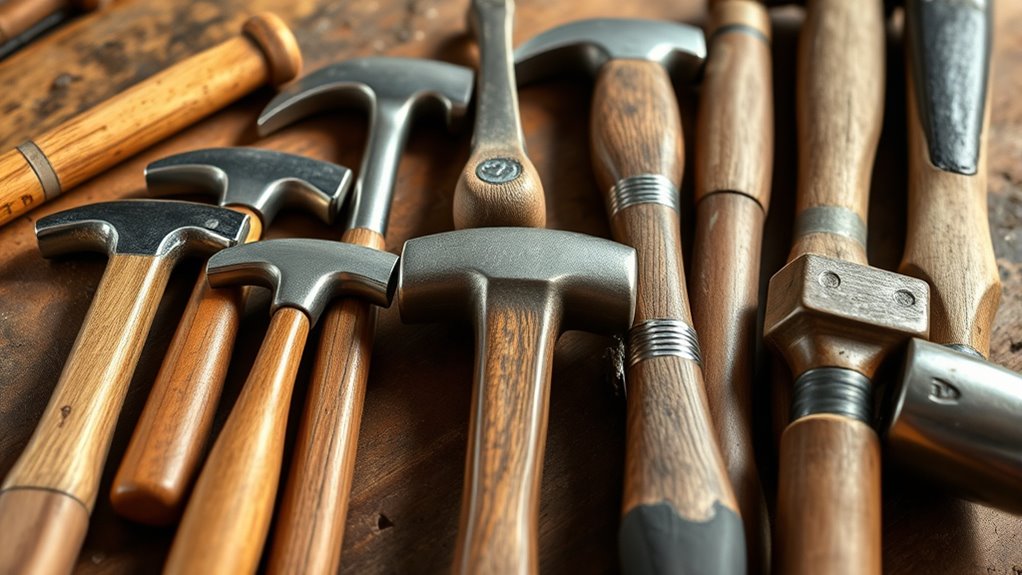Choosing the right hammer isn’t one-size-fits-all because your comfort, safety, and efficiency depend on factors like handle material, weight, and design suited to your specific task. A properly fitted hammer reduces fatigue and minimizes injury risk, while durable handles and heads ensure long-lasting performance. Different projects require different styles for maximum control. Keep these tips in mind, and you’ll discover how selecting the right hammer can make your work safer and more effective.
Key Takeaways
- Different tasks require specific hammer types and sizes for optimal efficiency and safety.
- Proper handle material and design improve shock absorption and durability, enhancing comfort during use.
- Ergonomic features ensure the hammer feels natural in the hand, reducing fatigue and injury risk.
- Matching the hammer to the work material and environment extends tool longevity and performance.
- Selecting the right size and style improves control, precision, and overall project success.

Are you choosing the right hammer for your project? Picking the perfect tool isn’t just about size or shape; it’s about understanding how it fits into your work and how comfortable and effective it will be. Ergonomic considerations play a big role here. You want a hammer that feels natural in your hand, reducing fatigue and the risk of injury during prolonged use. A poorly balanced hammer or one with an uncomfortable grip can cause strain in your wrist, arm, or shoulder, making your work harder and less precise. Look for tools with padded or textured handles that provide a secure grip, and ensure the weight distribution feels balanced when you hold it. The right ergonomic design lets you swing confidently without overexertion, leading to better control and less fatigue over time. Additionally, selecting a hammer with material durability in mind ensures it will stand up to the demands of your projects over time. material durability is equally crucial when selecting a hammer. You’ll want a tool made from high-quality materials that can withstand the demands of your projects. A hammer’s head should be crafted from hardened steel or other durable alloys to resist chipping, cracking, or bending, especially if you’re working on tough materials like concrete or dense wood. The handle’s material also matters; hardwood or fiberglass-reinforced composites tend to last longer and absorb shock better than cheaper, brittle plastics. A durable handle not only withstands repeated impacts but also maintains its integrity over time, ensuring safety and consistency as you work. When you choose a hammer with superior material durability, you’re investing in a tool that will serve you reliably across many projects, saving you money and frustration in the long run. It’s tempting to pick a hammer based solely on size or appearance, but considering ergonomic factors and material durability ensures you’re making a smarter choice. The best hammer for you is one that fits comfortably in your hand, reduces strain, and stands up to tough conditions without breaking down. Think about the type of work you do most often—whether it’s framing, finishing, or demolition—and select a hammer designed accordingly. Don’t overlook the importance of a well-made tool that offers both comfort and resilience. When you prioritize these aspects, you’re not just buying a hammer; you’re investing in a reliable partner that makes your work safer, faster, and more efficient.
Frequently Asked Questions
How Do I Choose the Right Hammer for Delicate Tasks?
To select the right hammer for delicate tasks, focus on an ergonomic grip that offers comfort and control, reducing hand fatigue. Look for a lightweight hammer made from durable materials like fiberglass or soft steel, which guarantees precision without causing damage. Avoid heavy or bulky hammers, and prioritize those with a softer striking face. This way, you work accurately, protect your work surface, and prevent unnecessary strain.
What Safety Precautions Should I Take When Using Different Hammers?
When you’re working with different hammers, safety should be your top priority. Always wear personal protective gear like safety glasses and gloves to shield yourself from flying debris. Keep your workspace organized and clear of obstructions to prevent accidents. Remember, safety doesn’t happen by chance — it’s a proactive effort. Always inspect your tools before use, and never strike a surface with a hammer that’s damaged or inappropriate for the task.
Can I Use One Hammer for Multiple Types of Projects?
You might wonder if one hammer can handle multiple projects, but it’s better to prioritize hammer versatility over tool specialization. While a claw hammer works for framing and light demolition, using the right tool guarantees safety and efficiency. Relying on one hammer for everything can compromise results and safety. So, investing in different hammers suited to specific tasks helps you work smarter, not harder, and keeps your projects safe and successful.
How Does Hammer Weight Affect Accuracy and Control?
Imagine you’re wielding Thor’s hammer—weight matters. Heavier hammers can improve impact, but they often compromise accuracy and control. Proper hammer ergonomics and weight distribution are key; a well-balanced hammer lets you swing precisely without tiring. Light hammers offer better control, ideal for delicate tasks, while heavier ones deliver more power. Choose based on your project, ensuring it’s comfortable and matches your strength for the best accuracy and control.
Are There Specific Hammers Recommended for Professional Versus DIY Use?
For professional use, you’ll want a hammer with an ergonomic grip and durable material to handle frequent, heavy-duty tasks comfortably. DIYers might prefer lighter hammers with a balanced weight that’s easier to control for occasional projects. Look for options that prioritize ergonomic grip for comfort and material durability for longevity. Choosing the right hammer depends on your specific needs, ensuring you work efficiently and safely whether you’re a pro or a hobbyist.
Conclusion
Choosing the right hammer isn’t just about size; it’s about finding the perfect tool that feels like an extension of your hand. When you select wisely, work becomes smoother and more satisfying—like a dance where every step is in harmony. Remember, a well-chosen hammer can turn a challenging task into a rewarding experience. So take your time, trust your instinct, and find that one tool that truly fits—you’ll wonder how you ever worked without it.









